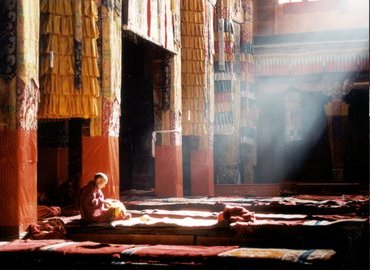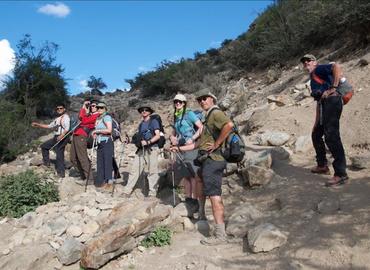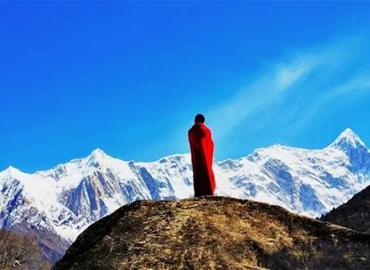Mani Stone - Mysterious Tibetan Folk Art
- Freya
- Last Updated : 04/23/2025
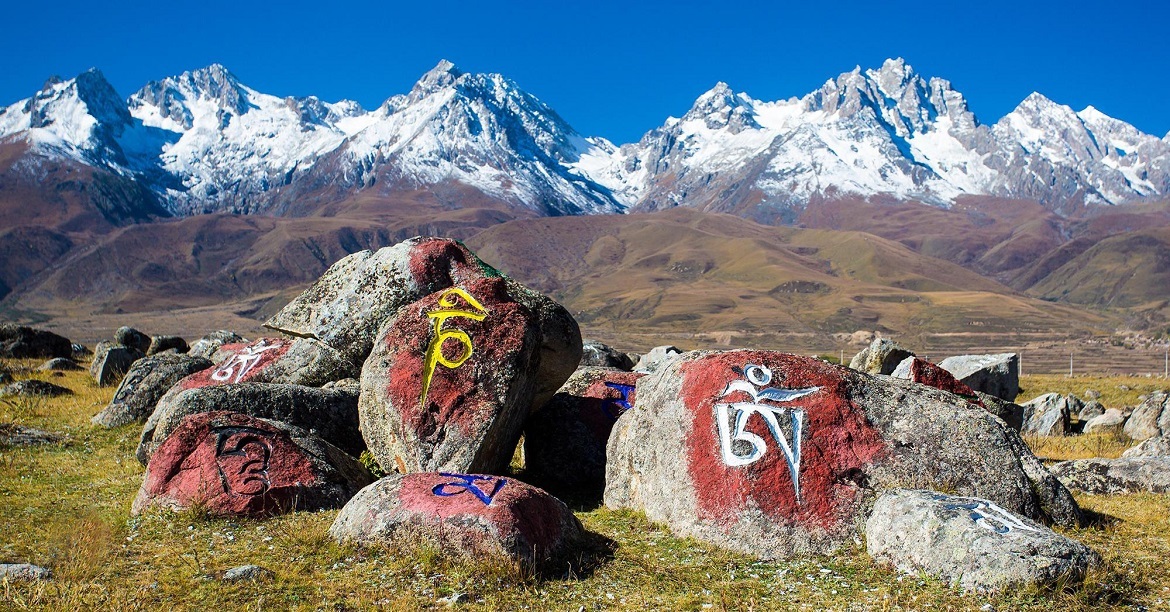
In Tibet, it’s easy to see many altars piled with stones and flagstones on hills, crossing roads, lakesides, and riverbanks. The altar was called Mani stone mound, which was made of Mani Stones. Most Mani Stones are engraved with six-word Dharani, mantras, eyes (in Buddhism, it means a mental perception), statues of gods, auspicious patterns, etc. They are masterpieces of Tibetan folk art.
The Origin of Mani Stone
"Mani" comes from the Sanskrit sutra "six-word Dharani" (Om Mani Padme Hum). Because of the stone engraved with "mani", people call it "Mani Stone" for short. Many people would think the Mani Stone is a derivative of Tibetan Buddhism, but that is not completely correct. Before Buddhism was spread to Tibet, Tibetans had their own indigenous religion, the Bon religion. It is the primitive religion in Tibet, which worships natural substances and natural phenomena such as the sky, earth, mountains, and water, and believes in animism. At that time people even regarded mountains and rocks as a presentation of mysterious and frightening powers. So they piled up Mani Stones at the places where they lived, lakeside, mountain passes, to show reverence toward deities, therefore expected to be guided and protected. After Buddhism was spread into Tibet, in order to integrate with the Bon religion, it also inherited the old customs and traditions of building stone mounds to worship the mountain god. Just something has been changed in the expressions and content. Mani Stone is then carved with Buddhist symbols and patterns such as mantras, scriptures, Buddha images, and various Buddhist symbols. Combined with the local region of Bon, Buddhism was updated to Tibetan Buddhism in Tibet.
With a great depth of aesthetic factors and characteristics, Mani Stone has become a unique Tibetan carving art. Devout Tibetan pilgrims believe as long as they engrave the six-word Dharani on the stones and chant the words day and night, those stones will enable supernatural spirits and bring them good luck and happiness. As people continually engrave the stone, more and more mani stones heap together, which form Mani stone mounds and Mani walls.
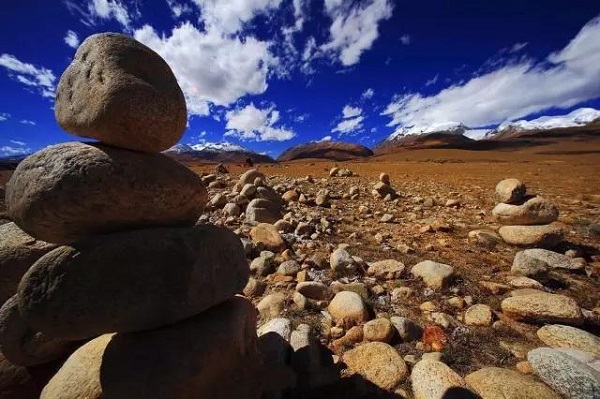
The Function of Mani Stones
In early times, there were many functions and purposes of the Mani Stone, some of which were built as a dwelling place for the Buddhas, to ensure the peace and prosperity of the tribes and families and avert disasters; some of which were built to worship gods, to accumulate merits; some of which were geographical boundary between tribes and villages; in addition, Maini Stones at mountain passes, bridges, main roads, which are to pray for the safety of the place.
Up to now, whenever Tibetans pass by Mani Stones, they would usually add a small stone, which is equal to reciting the sutras once. With the increase of Mani Stones, the mound constantly ascends. Some of the Mani Stones form hills, and many such hills connect together to form sacred walls. The walls are considered the boundary between the human world and the divine world, as well as the joint and connection points.
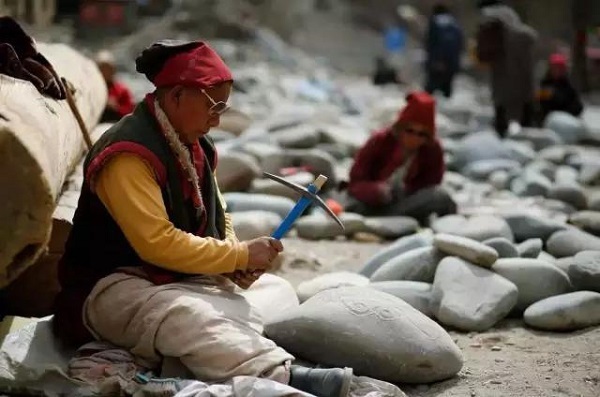
The Do's and Don'ts
If you come across a mani stone pile during your journey, approach it with reverence. Never climb on the mani pile, as doing so may be seen as disrespectful to the deities and local beliefs. Also, do not take any stones from it—each one carries a specific prayer or blessing, and moving or removing them can disrupt the sacredness of the mani pile. When taking photos, avoid any actions or poses that may be seen as disrespectful—such as sitting on a mani pile or pointing your feet toward it. These behaviors can be offensive to the local people and their beliefs.
According to tradition, one should walk around the mani pile in a clockwise direction, as if silently following the guidance of the local faith and culture.
The Shapes and Content of Mani Stones
The shape of the Mani Stone is generally square or round in the lower half, while the upper half is piled like a cone or hill, which originated from the worship of towering mountains and mountain gods on the Qinghai-Tibet plateau. Most Mani Stones are put on Ox horns, goat horns, or whole yak skulls; some even plug cypress branches or sticks in the stones, signifying swords, or hang on a strip of cloth on the branches or sticks, signifying souls. And colorful prayer flags were hung on the top or around the mani stones, which makes it beautiful and mysterious.
The content of the carvings on Mani Stones, early mainly with the Bon-worship thought of graphics and symbols, such as the sun, moon, dragon, fish, bird, beast, Swastika, etc. With the rise of Buddhism, the themes and contents of the stone carvings gradually changed into scriptures, incantations (six-word Dharani), Buddhas, Bodhisattvas, eminent monks, Buddhist pagodas, etc.

The Most Famous Mani Stone Sites
In the opinion of the Tibetan people, the stones on the plateau are sacred, and the Mani Stone has the spirits of divines. There are also many famous sites related to Mani Stones on the Qinghai-Tibet plateau.
Jiana Mani Stone City -- It is located in Yushu County, Qinghai province. It is the largest Mani stone mound in the world covering an area of two football fields size. Founded in 1715 by the first Rinpoche (also known as the living Buddha) of Jiana, the mani stone city has a history of more than 240 years, with a total of 2.3 billion sutra stones.
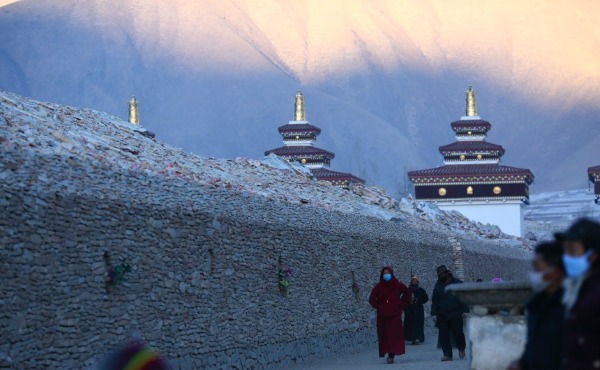
Qamdo Mani Mountain -- It is located in a village at the roadside of Heichang Path in eastern Tibet, with a history of more than 600 years. This Mani Stone mountain is at a height of more than 20 meters and the bottom of its circle is about 1 li. This mountain was piled up by Tibetan Buddhists who donated lots of wealth and effort for a long time. It's a kind of symbol that shows their devotion to Buddha and good.
Guge Mani Wall -- It's located in the ruins of the Guge Kingdom site in Tibet, with a history of 700 to 800 years. The Mani Wall is over one thousand meters long and inlaid over thousands of Mani flagstones, which are curved with colorful and exquisite Buddhist statues, scriptures, spells, and patterns, reflecting the prosperity of the ancient Zhang-Zhuang civilization and the cultural characteristics of Tibetan Buddhism in the later period.
Conclusion
The Mani Stone is more than just a carved rock—it is a profound expression of Tibetan spiritual belief, artistic heritage, and cultural continuity. From its ancient Bon origins to its integration with Tibetan Buddhism, the Mani Stone reflects the deep reverence Tibetans hold for nature, divinity, and the pursuit of blessings.
Email response within 0.5~24 hours.


